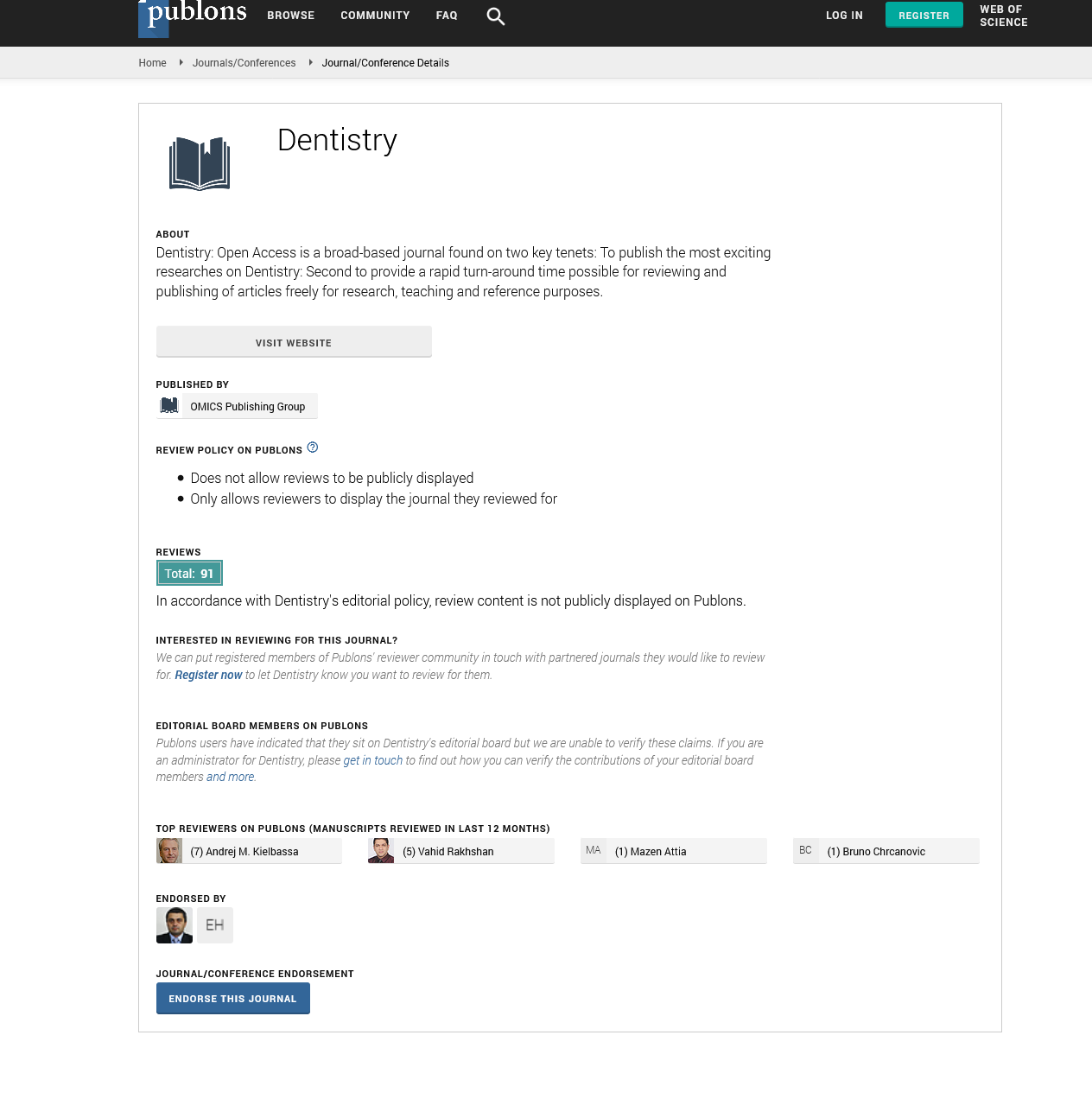Citations : 2345
Dentistry received 2345 citations as per Google Scholar report
Indexed In
- Genamics JournalSeek
- JournalTOCs
- CiteFactor
- Ulrich's Periodicals Directory
- RefSeek
- Hamdard University
- EBSCO A-Z
- Directory of Abstract Indexing for Journals
- OCLC- WorldCat
- Publons
- Geneva Foundation for Medical Education and Research
- Euro Pub
- Google Scholar
Useful Links
Share This Page
Journal Flyer

Open Access Journals
- Agri and Aquaculture
- Biochemistry
- Bioinformatics & Systems Biology
- Business & Management
- Chemistry
- Clinical Sciences
- Engineering
- Food & Nutrition
- General Science
- Genetics & Molecular Biology
- Immunology & Microbiology
- Medical Sciences
- Neuroscience & Psychology
- Nursing & Health Care
- Pharmaceutical Sciences
Commentary Article - (2024) Volume 14, Issue 4
Strategic Management of Proximal Enamel Caries using Glass Ionomer Cement and Silver Diamine Fluoride
Chaoran Wu*Received: 25-Nov-2024, Manuscript No. DCR-24-27039; Editor assigned: 27-Nov-2024, Pre QC No. DCR-24-27039 (PQ); Reviewed: 11-Dec-2024, QC No. DCR-24-27039; Revised: 18-Dec-2024, Manuscript No. DCR-24-27039 (R); Published: 26-Dec-2024, DOI: 10.35248/2161-1122.24.14.709
Description
Dental caries, particularly proximal enamel caries, are a common challenge in restorative dentistry. These carious lesions occur between adjacent teeth, where access is limited and effective intervention can be challenging. Effective prevention and management of these carious lesions are essential to maintaining oral health and preventing further complications.
Understanding proximal enamel caries
Proximal enamel caries develop between adjacent teeth, where plaque accumulation is frequent due to the limited visibility and accessibility of these areas. This type of carious lesion often begins as a demineralization process in the enamel, which can progress to more severe forms if left untreated. Early intervention is essential to halt the progression of these lesions and preserve tooth structure.
The role of glass ionomer cement restoration
Glass Ionomer Cement (GIC) is a widely used restorative material in dentistry due to its favorable properties. It releases fluoride, which can help remineralize the enamel and inhibit the progression of carious lesions. GIC is particularly useful for restoring cavities in areas with limited access, such as proximal surfaces.
Advantages of glass ionomer cement
Fluoride release: GIC releases fluoride ions over time, which helps in the remineralization of enamel and can prevent further carious activity. This property is especially beneficial in managing carious lesions in proximal areas where fluoride exposure might otherwise be limited.
Adhesion to tooth structure: GIC bonds well to both enamel and dentin, providing a durable restoration that helps to seal the cavity and prevent further bacterial infiltration.
Biocompatibility: GIC is well-tolerated by the surrounding dental tissues, reducing the risk of adverse reactions and providing a stable restoration.
Ease of application: The material is easy to handle and requires minimal preparation, which is advantageous for treating carious lesions in challenging proximal areas.
The role of silver diamine fluoride pretreatment
Silver diamine fluoride is a topical agent used to arrest carious lesions and enhance the effectiveness of restorative treatments. It contains silver, which has antimicrobial properties and fluoride, which aids in the remineralization of enamel.
Antimicrobial effect: Silver ions act to kill bacteria in the carious lesion, reducing the microbial load and halting the progression of carious activity.
Remineralization: Fluoride in SDF helps in the remineralization of early carious lesions, reinforcing the enamel and making it more resistant to future carious activity.
Ease of application: SDF can be applied directly to the affected tooth surface with minimal preparation, making it a convenient option for managing early carious lesions.
Cost-effectiveness: Compared to other treatment options, SDF is relatively inexpensive, making it an accessible choice for carious lesion management.
Integrated approach: Combining Glass Ionomer Cement with Silver Diamine Fluoride.
Restoration with glass ionomer cement: Following the SDF pretreatment, the next step is the restoration of the carious area with GIC. The tooth is prepared by removing any remaining decayed tissue and the GIC is applied to fill the cavity. The fluoride-releasing properties of GIC help to further protect the tooth from future carious activity, and its adhesive properties ensure a good seal against bacterial infiltration.
Monitoring and maintenance: After the restoration, regular monitoring is essential to ensure the long-term success of the treatment. Patients should be advised on proper oral hygiene practices and scheduled for follow-up visits to check the integrity of the restoration and the health of the surrounding teeth.
When using this combined approach, several clinical considerations should be taken into account.
Patient selection
This method is particularly effective for patients with early carious lesions and those at high risk for caries. It is also suitable for areas with limited access, where traditional restorative methods may be less effective.
Technique sensitivity
Proper technique in applying SDF and GIC is critical. Inadequate application or insufficient preparation can compromise the effectiveness of the treatment.
Patient compliance
Ensuring that patients adhere to follow-up visits and maintain good oral hygiene is essential for the success of this treatment strategy.
Citation: Wu C (2024). Strategic Management of Proximal Enamel Caries using Glass Ionomer Cement and Silver Diamine Fluoride. J Dentistry. 14:697.
Copyright: © 2024 Wu C. This is an open-access article distributed under the terms of the Creative Commons Attribution License, which permits unrestricted use, distribution, and reproduction in any medium, provided the original author and source are credited.

